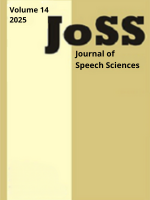Abstract
This pilot study aims at comparing two speech corpora in order to capture possible features of two different speech formats. The first corpus is a face-to-face speech corpus, the C-ORAL-BRASIL I (Raso and Mello, 2012) and the second corpus is a phone call corpus, part of the C-ORAL-BRASIL II (Raso; Mello; Ferrari, to appear), both in spontaneous informal Brazilian Portuguese. Through a pipeline prepared in Python, we compared: illocutionary complexity, informational density, overlapping, and disfluencies. Our results indicated that the speakers in the telephone calls had to use more vocal elements to convey a message while in face-to-face interactions the message would be divided in speech and gestures. The findings will be of interest to those who deal with speech corpora in different formats and are interested in selecting certain features for the comparison. Furthermore, this study has methodological ramifications because the elements examined here are very likely to occur in spontaneous speech in any format, and need to be compared carefully.
References
1. Almeida ANS de, Musiliyu O, Santana de Almeida RA, Oliveira JR. M. Correspondência e não correspondência prosódicas em aberturas de conversas telefônicas no português europeu. Rev Leitura [Internet]. 2014 Oct 11;2(52):293–316. Available from: https://www.seer.ufal.br/index.php/revistaleitura/article/view/1484
2. Austin JL. How to do things with words. Oxford: Oxford University Press; 1962.
3. Biber D, Conrad S. Register, genre, and style. Cambridge: Cambridge University Press; 2009.
4. Camelin N, Damnati G, Béchet F, De Mori R. Opinion mining in a telephone survey corpus. In: Interspeech; 2006 Sep.
5. Cavalcante FA. The information unit of Topic: a crosslinguistic, statistical study based on spontaneous speech corpora [PhD thesis]. Belo Horizonte: Universidade Federal de Minas Gerais; 2020.
6. Cresti E. Notes on lexical strategy, structural strategies and surface clause indexes in the C-ORAL-ROM spoken corpora. In: Cresti E, Moneglia M, editors. C-ORAL-ROM: Integrated reference corpora for spoken romance languages. Amsterdam/Philadelphia: John Benjamins; 2005.
7. Cresti E, Moneglia M. C-ORAL-ROM: Integrated reference corpora for spoken romance languages. Amsterdam: John Benjamins Publishing; 2005.
8. Cresti E, Moneglia M. Informational patterning theory and the corpus-based description of spoken language. The compositionality issue in the topic-comment pattern. In: Bootstrapping information from corpora in a cross-linguistic perspective. Firenze: Firenze University Press; 2010. p. 13–46.
9. Cresti E, et al. Corpus di italiano parlato. Introduzione e Campioni (II Voll.). Firenze: Accademia della Crusca; 2000.
10. Kosmala L. Beyond Disfluency: The interplay of speech, gesture, and interaction. Amsterdam: John Benjamins; 2024.
11. Levshina N. Communicative efficiency. Cambridge: Cambridge University Press; 2022.
12. Liu Y, Fung P, Yang Y, Cieri C, Huang S, Graff D. HKUST/MTS: A very large scale Mandarin telephone speech corpus. In: Chinese Spoken Language Processing: 5th International Symposium, ISCSLP 2006, Singapore, December 13–16, 2006. Proceedings. Berlin Heidelberg: Springer; 2006. p. 724–35.
13. Lo WK, Ching PC, Lee T, Meng H. Design, compilation and processing of CUCall: a set of Cantonese spoken language corpora collected over telephone networks. In: Proceedings of Research on Computational Linguistics Conference XIV; 2001 Aug. p. 193–212.
14. Mello H. Methodological issues for spontaneous speech corpora compilation. The case of C-ORAL-BRASIL. In: Spoken Corpora and Linguistic Studies; 2014. p. 27–68.
15. Moneglia M. Spoken corpora and pragmatics. Rev Bras Linguist Apl. 2011;11:479–519.
16. Moneglia M, Raso T. Notes on the language into act theory. In: Spoken corpora and linguistic studies. Amsterdam: John Benjamins Publishing Company; 2014. p. 468–95.
17. Pate JK, Goldwater S. Talkers account for listener and channel characteristics to communicate efficiently. J Mem Lang. 2015;78:1–17.
18. Pereira e Silva W, de Souza Melo MS, Gomes do Vale RP. Prosódia e construção de ethé discursivos em crimes via telefone. Fórum Lingüístico. 2017 Oct 1;14(4).
19. Raso T, Mello H, editors. C-ORAL-BRASIL: corpus de referência do português brasileiro falado informal I. Belo Horizonte: Editora UFMG; 2012.
20. Raso T, Mello H, Ferrari L. C-ORAL-BRASIL II. To appear.
21. Raso T, de Melo Rocha BNR, Salgado JV, Cruz BF, Mantovani LM, Mello H. The C-ORAL-ESQ project: a corpus for the study of spontaneous speech of individuals with schizophrenia. Lang Resour Eval. 2024;58(3):903–23.
22. Reed BS. Beyond the particular: Prosody and the coordination of actions. Lang Speech. 2012 Mar;55(1):13–34.
23. Rocha B, Raso T, Mello H, Ferrari L, et al. Information structure in the speech of individuals with schizophrenia: Methodology and first analyses from complex structure of corpus based data. CHIMERA Rev Corpus Lenguas Romances Estud Linguísticos. 2022;9:217–42.
24. Schegloff EA. Overlapping talk and the organization of turn-taking for conversation. Lang Soc. 2000;29(1):1–63. doi:10.1017/S0047404500001019.
25. Šturm P, Skarnitzl R, Nechanský T. Prosodic accommodation in face-to-face and telephone dialogues. In: Interspeech; 2021. p. 1444–8.
26. Vinciarelli A, Chatziioannou P, Esposito A. When the words are not everything: the use of laughter, fillers, back-channel, silence, and overlapping speech in phone calls. Front ICT. 2015;2:4.
27. Vital Á, Rocha B. Disfluencies classification: a corpus-driven approach. In: Proceedings of the 2nd International Conference on Data & Digital Humanities: Generative Artificial Intelligence for Text and Multimodal Data; University of Minho (Portugal). In press.

This work is licensed under a Creative Commons Attribution 4.0 International License.
Copyright (c) 2025 João Victor Pessoa Rocha, Átila Augusto Soares Vital


